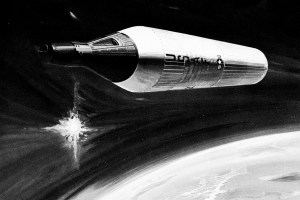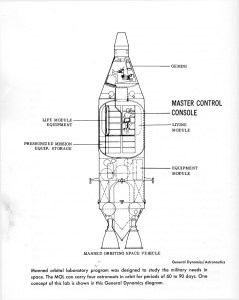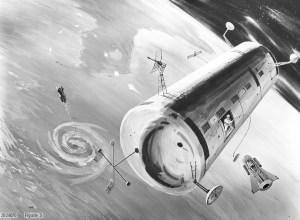
Image credit: USAF
Image source: National Archives

Above: A beautiful rendering of a Gemini B / MOL by Numbers Station favorite John Sentovic found in the Krafft Ehricke Papers. Below: Gorgeous artwork of same by Lockheed artist Ludwik Źiemba. At first glance you’d be forgiven for thinking they were the same image, I certainly did. My guess is that both are based on the same cutaway by a McDonnell draughtsman. The industry term for this is, “heavily referenced.”

Image credit: Krafft Ehricke Papers / Lockheed

Into The Unknown
by Don Dwiggins
Golden Gate Books, 1971
Image credit: McDonnell
Image source: Numbers Station

A manned orbital space space laboratory would be able to operate for several months without resupply. Basic Garrett-AiResearch systems could be slightly modified to meet requirements for environmental control, life support, cryogenic storage, power and attitude control for both the command module and laboratory.
Space World
December 1964, VOL. A-14
Image credit: Garrett-AiResearch
Image source: Numbers Station

The MOL – Manned Orbiting Laboratory – is shown, in this artist’s view, being lifted into space by the Titan III C. On top of the cylindrical canister, the crew sit in a modified Gemini capsule.
Orbiting Stations: Stopovers to Space Travel
Irwin Stambler
G.P. Putnam’s Sons, 1965
Image credit: USAF
Image source: Numbers Station

Orbiting Stations: Stopovers to Space Travel
Irwin Stambler
G.P. Putnam’s Sons, 1965
Image credit: McDonnell
Image source: Numbers Station

Carefully watching the displays on their instrument panel, two astronauts in their Gemini ferry prepare to rendezvous with the MOL.
Orbiting Stations: Stopovers to Space Travel
Irwin Stambler
G.P. Putnam’s Sons, 1965
Image credit: USAF
Image source: Numbers Station

A 1960 concept image of the United States Air Force’s proposed Manned Orbiting Laboratory (MOL) that was intended to test the military usefulness of having humans in orbit. The station’s baseline configuration was that of a two-person Gemini B spacecraft that could be attached to a laboratory vehicle. The structure was planned to launch onboard a Titan IIIC rocket. The station would be used for a month and then the astronauts could return to the Gemini capsule for transport back to Earth. The first launch of the MOL was scheduled for December 15, 1969, but was then pushed back to the fall of 1971. The program was cancelled by Defense Secretary Melvin R. Laird in 1969 after the estimated cost of the program had risen in excess of $3 billion, and had already spent $1.3 billion. Some of the military astronauts selected for the program then transferred to NASA and became some of the first people to fly the Space Shuttle, including Richard Truly, who later became the NASA Administrator.
Image # : 2B24070-Fig3
Date: Circa 1960
Image credit: McDonnell
Image source: NASA on The Commons

Manned Orbiting Laboratory (MOL), an evolution of the earlier “Blue Gemini” program, which was conceived to be an all-Air Force parallel of NASA’s Gemini efforts. (U.S. Air Force photo)
Image credit: USAF
Image source: USAF Museum